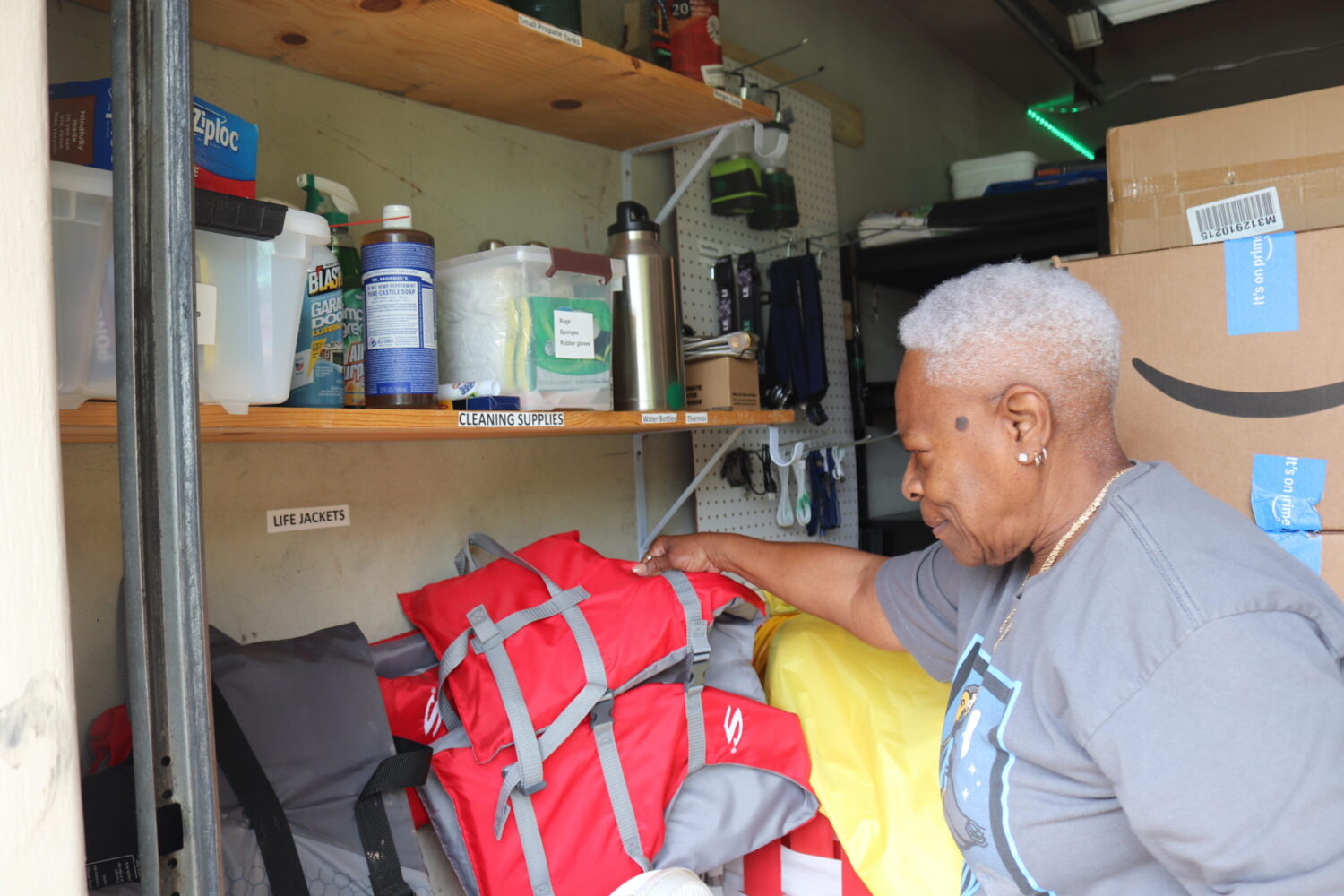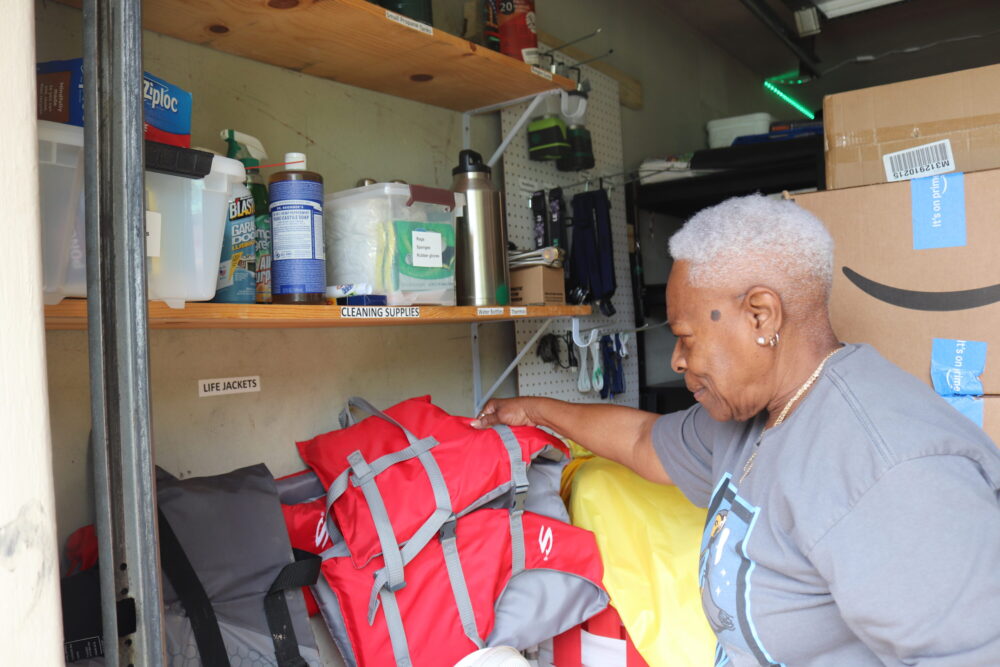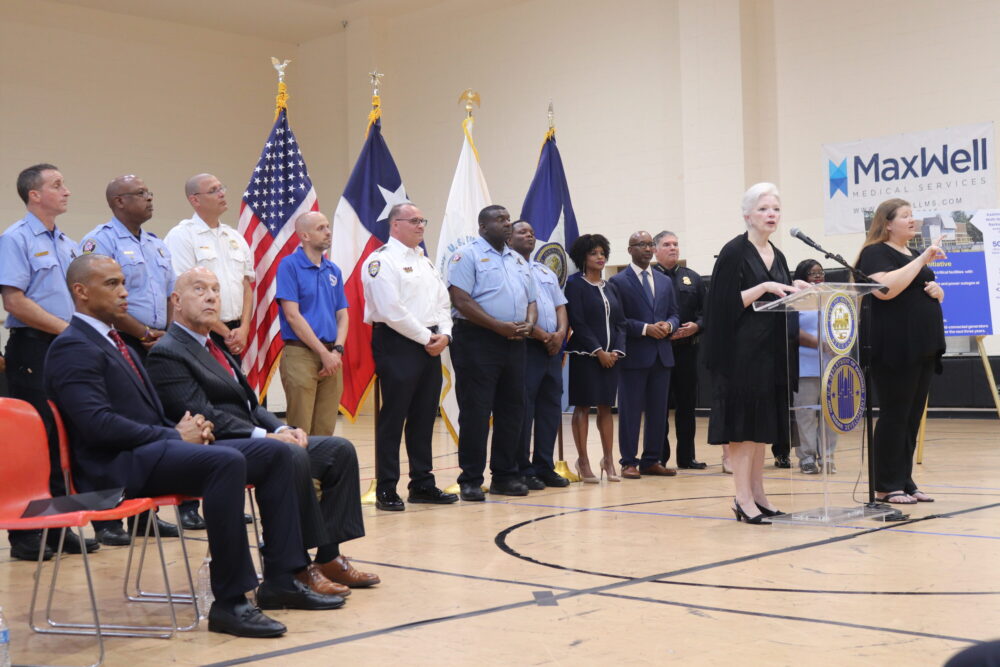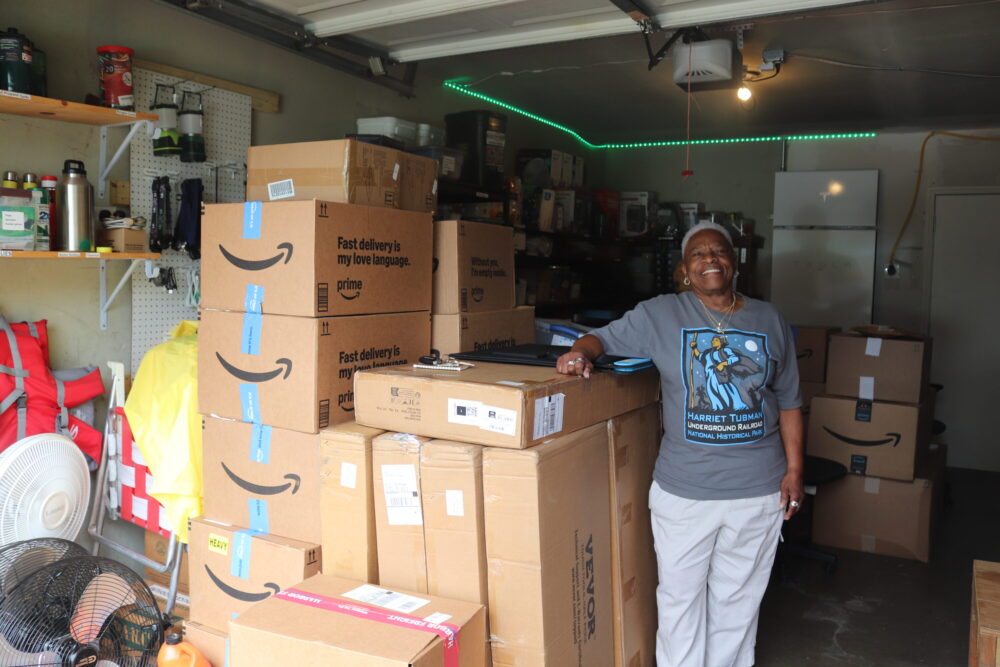Dominic Anthony Walsh/Houston Public Media
Doris Brown looks through storm supplies in the garage of her home, which is a designated “hub house” in Northeast Houston.
In the living room of Doris Brown’s home in Northeast Houston, emergency supplies take up a lot of space. Cases of water, battery-powered fans, flashlights and hygiene products stand ready for distribution to seven other “hub houses” across the area.
A hub house is like “a port in a storm,” Brown explained, with the house captains serving as the “boots on the ground” for their neighborhoods.
“We all have rosters of people in our communities that are bedridden, that need insulin, those that have children, and we’re there for their needs,” she said.
Her own hub is based in the garage, where more supplies line the walls. With portable power generators and a Tesla home battery connected to a rooftop solar array, she’s ready for power outages like the ones that affected more than 2 million households and businesses in Houston last summer in the aftermath of Hurricane Beryl.
Click here for more inDepth features.
Brown is a co-founder of activist group Northeast Action Collective and co-director of nonprofit West Street Recovery, which led fundraising for the hub houses in the aftermath of the deadly winter storm in 2021.
“No one was coming to help us,” Brown said. “If we didn’t do it for ourselves, we were just going to be left. Municipalities, the governments — they’re a day late and a dollar short.”
Most Houston-area residents feel the same way, according to a survey by Rice University’s Kinder Institute for Urban Research. Nearly 60% of respondents said local officials and leaders were not well prepared for Hurricane Beryl, which caused widespread power outages and dozens of local deaths last July.
The same percentage said they were worried about climate change. Driven by man-made fossil fuel emissions, the climate crisis is expected to fuel more frequent and more severe storms. Meanwhile, a key pillar of city leaders’ resiliency plan could take up to three years to execute.
Brown was busy after the derecho and Hurricane Beryl last year, distributing supplies and checking in with neighbors.
For residents around Brown’s hub house, there were few alternatives during Hurricane Beryl. The nearest community center on Tidwell Road didn’t have a backup power generator. Under a plan from Houston Mayor John Whitmire’s administration, that will change.
“Those generators are a good idea, and they should have been done a long time ago,” Brown said.
Slow progress toward municipal resilience
When Beryl struck, only one of the city’s 13 multiservice community centers had a generator. In fact, of the more than 350 city-owned buildings, Whitmire’s administration has identified 140 “priority assets” that need backup power.
“I was stunned,” said Angela Blanchard, the city’s chief recovery and resiliency officer.
Dominic Anthony Walsh/Houston Public Media
Angela Blanchard, right, the chief recovery and resiliency officer for the City of Houston, speaks during an event including Mayor John Whitmire and U.S. Secretary of Housing and Urban Development Scott Turner on June 24, 2025.
She inherited a “Resilient Houston” plan created in 2020 under former Mayor Sylvester Turner. It called for addressing power loss at critical city facilities, but little progress was made.
“There were quite a few things in the plan that had not been executed, so we’ve been encouraged to focus on execution,” Blanchard said.
That includes spending more than $150 million in federal recovery funds on the “power protection initiative” at 100 city-owned sites, including community centers, police and fire stations, water infrastructure and other city facilities within the next three years.
That plan itself is controversial. Brown is supportive of the power protection initiative, which will take up about half of the $315 million in recovery funds awarded after the storms in 2024. But her groups are critical of the relatively small amount allocated toward housing — $50 million, despite about $230 million in identified “unmet needs” related to housing.
“If we do not address this unmet need for housing, it is going to be many more homeless people out there,” Brown said.
The city plans to allocate about $40 million toward homeless services along with $32 million to build debris removal capacity. After protests over the initial plan to allocate $0 toward housing, the administration moved $50 million away from planned purchases of emergency vehicles.
The administration argued Hurricane Beryl underscored the city’s lack of resilience, which the housing department said the city’s recovery dollars should bolster.
But, Blanchard said, the city can only do so much. Individual households and communities need to also prepare.
“This is where you see these community hubs that are being created,” she said. “We’re so enthusiastic about seeing that level of activity on the ground in neighborhoods because the fundamental unit of resilience is the home, then the community.”
Houstonians feel prepared for disasters despite lack of preparation
In Houston, the eight community hubs in the northeast part of town are outliers.
When it comes to residents’ disaster preparedness, there is “inconsistency between feeling prepared and then taking actual preparation steps,” said Dan Potter, director of the Houston Population Research Center at Rice University’s Kinder Institute for Urban Research.
Dominic Anthony Walsh/Houston Public Media
Doris Brown’s home is one of eight “hub houses” in Northeast Houston that aim to provide community members with critical resources during a storm.
According to a survey by the Kinder Institute, the typical Houstonian has taken 3 of the 10 steps recommended by the Federal Emergency Management Agency (FEMA) to prepare for a disaster. But 68% feel prepared.
More than half of residents took only two preparation actions, charging their phones and batteries as well as filling up their vehicles’ fuel tanks, in advance of Hurricane Beryl, a category 1 hurricane that passed almost directly over the city.
FEMA’s recommendations include:
- Making your home safer
- Signing up for alerts and warnings
- Documenting and insuring property
- Saving for a rainy day
- Knowing evacuation routes
- Safeguarding documents
- Assembling and updating emergency supplies
- Making a household family emergency plan
- Testing family communication plan
- Practicing emergency drills
In the Houston area, 4 in 10 of those actions had been taken by more than half of residents.
Potter pointed out there’s only so much preparation residents can do, especially if they face economic constraints.
“When we are talking about disaster preparation, I just think it’s critically important to recognize we are talking about taking steps that help us get through the first 24, 48, 72 hours,” Potter said. “When we begin shifting past that, but we’re still talking about putting the burden of preparedness and response and recovery on the individual, those are circumstances where disparities and inequalities and resources is going to become incredibly important.”
The lack of preparedness by most Houstonians stood in stark contrast to the hub homes in Northeast Houston — though Potter says the difference could speak to how those neighborhoods perceive the government.
“There’s definitely ways in which it is speaking to a community knowing that no one’s coming for them,” Potter said.
That’s exactly how Doris Brown feels — especially in light of the accelerating climate crisis.
“We have to look out for ourselves,” Brown said. “I’m just hoping that everyone will get prepared and stay prepared for these eventualities. Because there are going to be more, and if we’re not prepared, we might get washed away.”



